If driving through Europe from the UK you’ll already have experienced the French ‘péage’ system of motorways and motorway tolls but, if continuing south, you’ll encounter ‘autostrade’ the Italian motorway network, also in the main, subject to tolls. Again, it’s possible to avoid the toll roads but the network has been designed so as to be the roads of choice for drivers wanting to get just about anywhere important in the country. The network is larger in the more densely populated north snaking out along each coast as it heads south with occasional autostrade traversing the centre. The most popularly used autostrade is also an icon of the European road trip fraternity, the ‘Autostrada del Sole’ which links
Milan with
Naples. It’s commonly called the ‘AutoSole’ and covers 754 kilometres for a toll fee of around 55 euros.
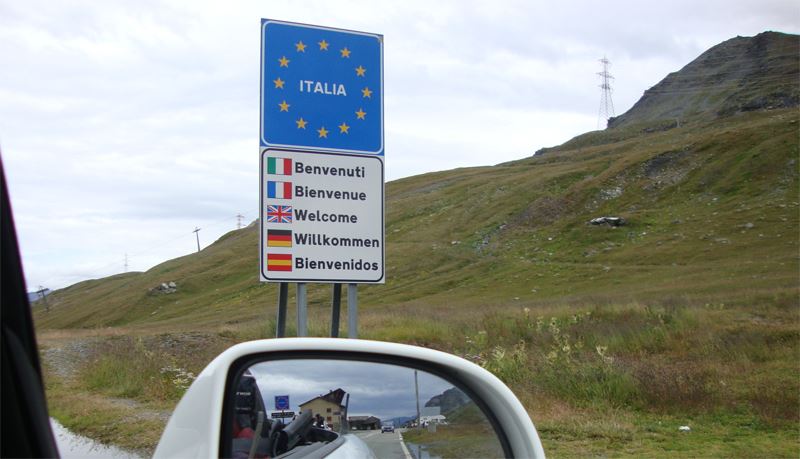
Not all autostrade incur tolls, those which are ring roads around cities are free from tolls, as is the stretch of the A3 between Salerno and Reggio di Calabria which is owned by a separate company which does not charge tolls.
Avoiding the autostrade is possible although not easy in many regions but the quality of Italy’s secondary roads together with congestion in the many towns and cities along the route mean that paying what seems to be a costly toll charge is worth it to avoid the stress and substantially longer journeys off the autostrade. Our recommendation to those wanting to cut costs is to plan the journey carefully so that you choose secondary roads in more attractive regions and use the autostrade to avoid big towns and cities and for the longer parts of your journey.
History of Toll Roads in Italy
The Italians were the first country in the world to build motorways which they called ‘Autostrade’. The first ever constructed was the Milan to Laghi autostrade which opened in 1924 and was completed two years later. By the end of the 1930s, Italy had over 400kms of autostrade crossing the country, much of which was funded by tolls. The Second World War ravaged Italy’s infrastructure and to help repair the road system and so boost the economy, private initiatives were encouraged but it wasn’t until1964 that the first modern autostrade – the Autostrada del Sole opened.
From that point, all new autostrade construction was undertaken by private companies with the tolls set to enable them to repay capital costs and to make a profit. Today, almost all the autostrades are owned by two companies; Atlantia and ANAS and tolls are set after reference to the government.
Italy now has 3408kms of autostrade stretching from the borders with France, Switzerland and Austria down to the toe of Italy and on into Sicily.
Using the Toll Roads
There are different approaches to the use of the autostrade toll system, depending on the company that owns the stretch and the region. On the whole, you’ll take a ticket when you join, inserting it in a machine as you leave the autostrade network before being told the toll you must pay. Losing your ticket will mean you’ll have to pay as if you joined at the start of that stretch.
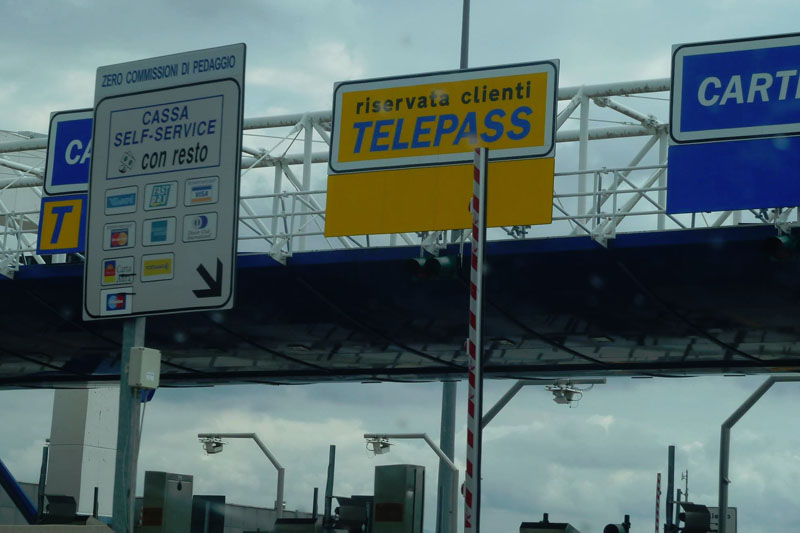
You can also rent an automatic toll payer called Telepass that sits under the windscreen and electronically calculates the toll before debiting it to your bank or credit card account. On some autostrade, particularly the A8 and A9, you’ll find barriers and booths where you’ll pay the toll to a machine or an operative. The charge is fixed no matter how far you’ve travelled.
Cost - How Much Do Toll Roads in Italy Cost?
As all of the autostrades are interlinked in Italy’s road network, the charges for tolls are proportional to the distance travelled. This means around a euro for every seven kilometres, around 50% more than in France. On some shorter stretches, charges may be slightly higher. Secondary roads parallel many of the autostrades but mean that you’ll regularly be driving on slow, congested and often not very attractive roads which, for the euro saving, can double or triple your journey time.
There are advantages and disadvantages with each:
Using Toll Roads
Advantages:
Disadvantages:
- You’ll get there quicker because traffic is lighter and the autostrade are more direct and will have a higher speed limit- 81 mph in general with some parts having a limit of 93 mph.
- Maintaining an average speed saves on fuel consumption
- The roads are better maintained
- The cost of around a euro per 7 kilometres
- The routes avoid towns and cities so mostly you’ll just see concrete or tarmac and countryside for hundreds of miles
- Fuel prices are much higher on the autostrades and service stations sell typically bland food and drink if you stop there for a break
Using Other Routes
Advantages:
Disadvantages:
- No charges for travelling on them
- Many will pass through villages, towns and cities meaning you can stop off and see some of Italy’s sights
- Fuel is cheaper in the towns and villages and you’ll find beautiful cafes and restaurants for a taste of regional Italian cuisine
- Driving will be much more interesting with less chance of becoming drowsy from the monotony of the route
- The journey time will be much longer as autostrade are typically 10-20% shorter for journeys between A and B
- Fuel costs will be higher because of the extra distance and irregular travelling speeds
- Roads are less well maintained and there’s a greater chance of getting lost; even with a sat-nav
Sample routes and their costs:
- The A1 from Florence to Rome: 274 kms; €17.60 / Journey time approximately three hours
- The A16 from Naples to Bari: 266 kms; €19 / Journey time approximately two and a half hours
- On the A1 from Rome to Naples: 229 kms; €15.80 / Journey time approximately two and a quarter hours
You can avoid the toll charges if you plan carefully. Many of the national routes are free and of a similar standard to the autostrada. For example, the journey from Naples to Bari can be undertaken on the E45 to the south of the autostrade but increase your journey length by an hour and a distance of 22kms.
Route planners will give you the toll free next quickest route but if distance saving is more important than time, you can plan direct routes on secondary roads which will save fuel.
Selected Routes - Popular Toll Road Journeys in Italy
Naples to Bari by Toll Road
Toll Charges
€19 on the A16
Bari is one of Italy’s hidden gems, hidden because most people use this port city only to arrive at or leave Italy. Leave Naples, travelling northeast on the A16 towards Casori before cutting east. Avelino is the first city of note you’ll encounter. Take a detour on the SS372 to visit historic Benevento or carry on along the A16, keeping the mountains of Campania on your right. Entering Puglia, you’ll endure a long stretch of flat, dull, open countryside with occasional industrial areas. At Conosa di Puglia, the A16 becomes the A14 and continues on to Bari. Just past Andria, turn off onto the SS16 coast road for some better scenery.
Venice to Trieste by Toll Road
From
Venice you’ll head east on to the last Italian city before Croatia. Both cities are stunning in different ways and
Trieste is the perfect spot on the route to the beautiful Croatian island of Krk. To get there, leave the lagoon city on the SS11, crossing to Mogliano Veneto before joining the E70/A4 travelling northeast. The route has some interest along it with the Italian Alps to your distant left and the Adriatic Sea to your right. You can get closer to the sea following the toll free SS14 which has some interesting links to the coast.
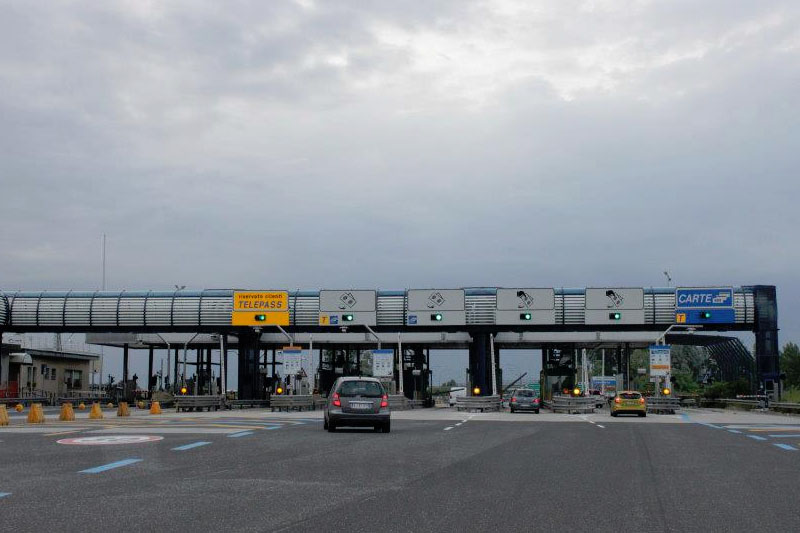 Milan to Genoa by Toll Road
Milan to Genoa by Toll Road
Leave Milan south on the A7 (E62) and head for Tortona. The journey follows a route through farmland and industrial areas before rising up through the Antola National Park, a region of hills and low mountains. Soon the expanse of the historic port and industrial city of
Genoa will come into sight. Alternative routes between the cities are long, slow and tortuous, not recommended for those short of patience!
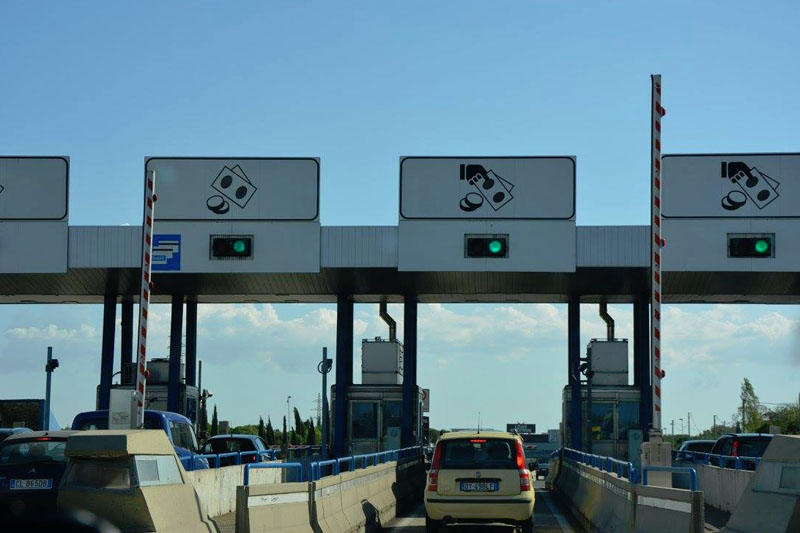 Turin to Aosta by Toll Road
Turin to Aosta by Toll Road
One of the few autostrade that is a beautiful drive too, the route from
Turin to the French ski resorts travels via Aosta in the valley that bears its name. Start by heading north to Ivrea before the autostrade begins to ascend the southern flanks of the French Alps. It can be a fairly bleak climb, especially in winter if you’re aiming for the ski resorts but soon you’ll reach Aosta. From there the SS24 heads towards Chamonix whilst the SS27 goes north into
Switzerland for Montreux and the shores of Lake
Geneva. To avoid tolls, the SS26 closely parallels the A5 but is more treacherous in winter.
Turin to the Frejus Tunnel (for France)
This is a wonderful route linking the city of Turin or Torino with
France via the Tunnel of Frejus which leads into the mountainous area of the Vanoise National Park and on to the ski resort of Val d’Isere. Leaving Turin on the Corso Regina Margharita, you’ll join the A55 by IKEA, follow the road west onto the E70 through Susa and Bardonecchia. The road will eventually turn north for the Frejus Tunnel into France. If you want to avoid the tolls, the secondary road SS24 closely follows the A55/E70 along its route but with no charge.
Map of Toll Roads in Italy
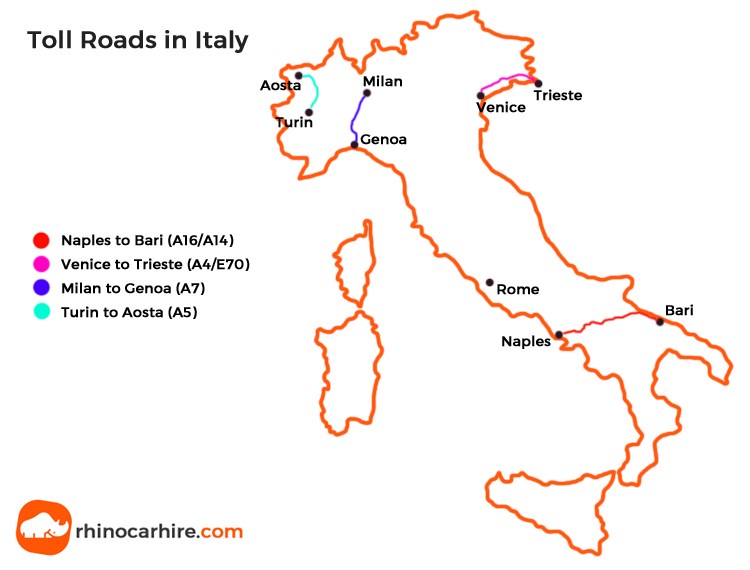
Further Reading on Driving in Italy;